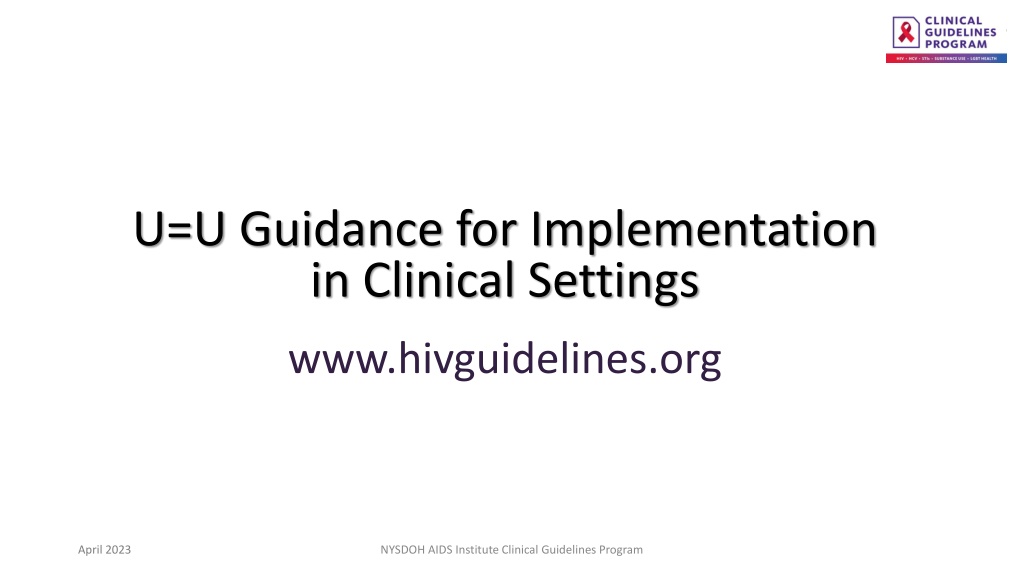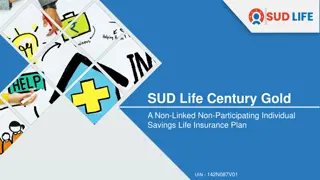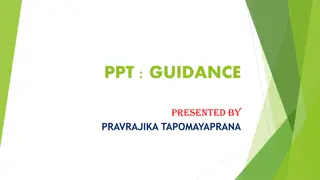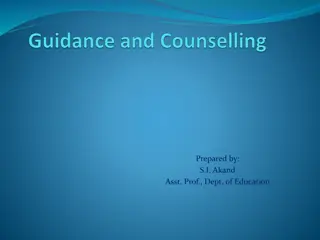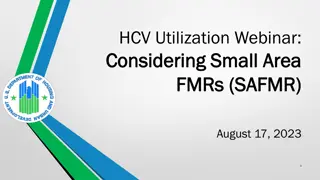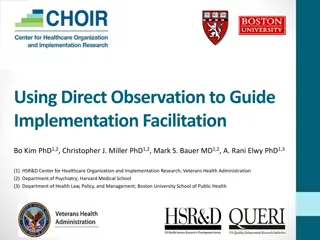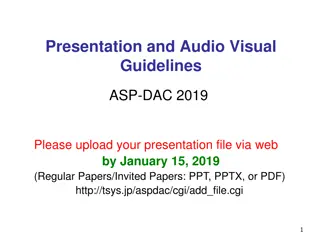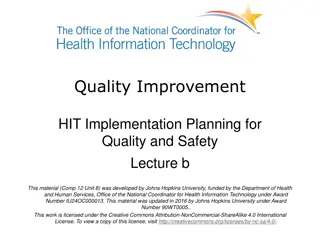U=U Guidance for Implementation
U=U, Undetectable=Untransmittable, is a scientific concept demonstrating that individuals with viral suppression do not transmit HIV. Supported by studies like HPTN 052 and PARTNER, this strategy requires adherence to ART for effective HIV prevention
Download Presentation

Please find below an Image/Link to download the presentation.
The content on the website is provided AS IS for your information and personal use only. It may not be sold, licensed, or shared on other websites without obtaining consent from the author.If you encounter any issues during the download, it is possible that the publisher has removed the file from their server.
You are allowed to download the files provided on this website for personal or commercial use, subject to the condition that they are used lawfully. All files are the property of their respective owners.
The content on the website is provided AS IS for your information and personal use only. It may not be sold, licensed, or shared on other websites without obtaining consent from the author.
E N D
Presentation Transcript
U=U Guidance for Implementation in Clinical Settings www.hivguidelines.org April 2023 NYSDOH AIDS Institute Clinical Guidelines Program
Glossary Glossary Viral load suppression: A measured quantitative HIV RNA level <200 copies/mL in blood Undetectable viral load: An HIV viral load that is below the level of detection on a specific assay, typically HIV RNA <20 copies/mL to 50 copies/mL Durably undetectable: An undetectable viral load maintained for at least 6 months. This indicates that an individual s undetectable HIV viral load is stable and they will not transmit HIV through sex if they continue to adhere to treatment. Untransmittable: As established by various clinical trials and observational studies, individuals who maintain an undetectable viral load have so little HIV in their blood and other secretions that they have no risk of passing HIV to others through sex. Virologic blip: When an individual s HIV is initially undetectable on a viral load test, then is at a low but detectable level on a repeat viral load test (usually HIV RNA of 20 to 200 copies/mL, but can be higher), and is again measured at an undetectable level shortly thereafter April 2023 NYSDOH AIDS Institute Clinical Guidelines Program www.hivguidelines.org
What is U=U? What is U=U? Undetectable=Untransmittable, or U=U, is the scientific finding that people who achieve and maintain viral suppression (HIV RNA <200 copies/mL) do not transmit HIV through sex. U=U is promoted by the Prevention Access Campaign and is endorsed by the CDC and the NYSDOH. April 2023 NYSDOH AIDS Institute Clinical Guidelines Program www.hivguidelines.org
Evidence Supporting U=U Evidence Supporting U=U The HPTN 052, PARTNER, PARTNER 2, and Opposites Attract studies followed thousands of male and heterosexual HIV-serodifferent couples. There were no genetically linked HIV transmissions when the partner with HIV was taking ART and was virally suppressed (HIV RNA <200 copies/mL). These studies provide robust evidence that individuals do not sexually transmit HIV if they are virally suppressed or have an undetectable viral load. April 2023 NYSDOH AIDS Institute Clinical Guidelines Program www.hivguidelines.org
Applying U=U to Clinical Practice Applying U=U to Clinical Practice U=U is grounded in adherence: Maintaining an undetectable viral load is foundational to the U=U strategy but may be functionally challenging for many individuals with HIV. It is recommended that consistent adherence to ART is demonstrated before relying on U=U as a sole, effective HIV prevention strategy. Adherence may be confirmed with: Two consecutive undetectable viral load test results separated in time (e.g., by at least several weeks or more); or A full 6-month period during which all viral load test results are undetectable (more conservative) April 2023 NYSDOH AIDS Institute Clinical Guidelines Program www.hivguidelines.org
Applying U=U to Clinical Practice Applying U=U to Clinical Practice, continued U=U is grounded in monitoring: Per NYS guidelines, viral load testing should be performed: Every 4 months after an individual achieves an undetectable viral load If viral suppression and stable immunologic status are maintained for >1 year, then viral load testing can be extended to every 6 months in select patients thereafter April 2023 NYSDOH AIDS Institute Clinical Guidelines Program www.hivguidelines.org
U=U Best Practices U=U Best Practices Adherence: Ask patients if anything might make it difficult for them to consistently take their medicines and address any likely barriers to adherence, which may include poverty, housing instability, and other key social factors, and offer all available support, referrals for assistance, and other interventions, along with HIV prevention strategies that do not rely on viral suppression. Viral load monitoring: Follow existing NYS guidelines for monitoring viral load in patients on treatment. Screening and treatment for STIs (other than HIV): Encourage all patients to get tested for STIs. Consider offering STI screening every 3 months (as with PrEP) for all individuals with HIV who rely on U=U as a sole strategy to prevent the sexual transmission of HIV. April 2023 NYSDOH AIDS Institute Clinical Guidelines Program www.hivguidelines.org
What About U=U and What About U=U and HIV RNA in Genital Secretions? Virologic Blips ? Breastfeeding? Injection Drug Use? Needlestick Injuries? Patients on previously suppressive ART with newly detectable viral loads may be experiencing low-level transient viremia ( blips ) and not virologic failure. Virologic blips likely occurred in individuals participating in HPTN 052, PARTNER, PARTNER 2, and Opposites Attract; still, there was no transmission from people whose measured HIV viral load was consistently suppressed. There is no evidence that detectable virus in genital secretions while plasma viral load is undetectable is associated with transmission. Studies demonstrate that ART greatly reduces the risk of HIV transmission from individuals who breastfeed their babies. However, research has not established that people whose HIV is undetectable do not transmit HIV during breastfeeding. Studies demonstrate that ART greatly reduces the risk of HIV transmission through sharing of injection drug use equipment. However, research has not established that people with an undetectable HIV viral load do not transmit HIV through needle sharing. Research has not established that people with an undetectable HIV viral load do not transmit HIV to people who are stuck by a needle containing their blood. HIV PEP may be indicated. April 2023 NYSDOH AIDS Institute Clinical Guidelines Program www.hivguidelines.org
Ensuring Equitable Access to Knowledge About U=U Ensuring Equitable Access to Knowledge About U=U Research has established that certain groups, including sexual and racial or ethnic minority groups, report decreased awareness of or are less likely to be counseled on U=U. Care providers are encouraged to make an extra effort to ensure that all patients with HIV are made aware of the importance of U=U and its implications. April 2023 NYSDOH AIDS Institute Clinical Guidelines Program www.hivguidelines.org
Inform All Patients About U=U Inform All Patients About U=U Care providers should inform all patients that: People who keep their HIV viral load at an undetectable level by consistently taking HIV medications will not pass HIV to others through sex. Sharing this message can help: Diminish stigma associated with having HIV Reduce barriers to HIV testing and treatment Increase HIV testing uptake Inform choices about whether or not to start or continue an HIV prevention method Increase interest in starting and staying on ART Improve self-esteem by removing the fear of being contagious Support healthy sexuality regardless of HIV status Reduce sex partners concerns. April 2023 NYSDOH AIDS Institute Clinical Guidelines Program www.hivguidelines.org
Counseling Individuals With HIV About U=U Counseling Individuals With HIV About U=U Encourage patients newly diagnosed with HIV and those previously diagnosed but not taking ART to immediately start (or restart) treatment. Explain that doing so will help them avoid damage to their body and immune system and will prevent transmission of HIV to their sex partners. The importance of ART should be framed primarily in terms of helping the individual with HIV maintain personal health. Prevention of transmission is a secondary, fortuitous effect of HIV self-care. Initiation of ART as soon as possible after diagnosis, even on the same day as diagnosis or at the first clinic visit, improves long-term outcomes, such as virologic suppression and engagement in care at 12 months. Reassure patients who may be worried or concerned about virologic blips. Explain that people who have virologic blips do not transmit HIV sexually as long as they continue to take ART consistently. April 2023 NYSDOH AIDS Institute Clinical Guidelines Program www.hivguidelines.org
What to Say to Patients About U=U What to Say to Patients About U=U Keeping your HIV undetectable helps you live a long and healthy life. To get your HIV to an undetectable level and to keep it undetectable, take antiretroviral medicines as prescribed. It may take up to 6 months of taking HIV treatment medicines to bring your HIV down to an undetectable level. If your HIV is undetectable and you are taking your medications as prescribed, you can be sure you will not pass HIV through sex. People who keep their HIV at an undetectable level will not pass HIV to others through sex. If you stop taking HIV medicines, your HIV can rebound to a detectable level within 1 to 2 weeks, and you may pass HIV to your sex partners. Keeping your HIV at an undetectable level helps you safely conceive a child with your partner. April 2023 NYSDOH AIDS Institute Clinical Guidelines Program www.hivguidelines.org
How Patients Can Discuss U=U With Others How Patients Can Discuss U=U With Others Counsel patients to share information about the research on U=U as follows: In 4 research studies that involved thousands of couples, no one who was on HIV treatment and whose HIV was undetectable passed HIV to their HIV-negative sex partner. Advise patients that they can share the following personal information with current or potential sex partners: When they last had a viral load test and if their viral load was undetectable. Note: Individuals should tell partners that their HIV is undetectable only if they have taken HIV medicines consistently since their last test with an undetectable viral load. April 2023 NYSDOH AIDS Institute Clinical Guidelines Program www.hivguidelines.org
Encourage STI Testing Encourage STI Testing Care providers should encourage all sexually active patients and their partners, particularly those who do not use condoms consistently, to get tested regularly for bacterial STIs. Regular testing and prompt treatment can reduce transmission of bacterial STIs among individuals and throughout the population. It is also important to inform patients that common STIs may be asymptomatic. April 2023 NYSDOH AIDS Institute Clinical Guidelines Program www.hivguidelines.org
Counseling Couples About U=U Counseling Couples About U=U HIV treatment: Couples may decide that ART and an undetectable viral load for the partner with HIV provide sufficient protection against HIV transmission. PrEP: PrEP is a safe and effective daily pill that prevents HIV infection. The partner without HIV may decide to take PrEP if they: Are unsure that their partner s HIV viral load is undetectable, especially if their partner has only recently started ART. Have more than 1 sex partner. Feel more secure with the added perception of protection provided by PrEP. (See the NYSDOH AI guideline PrEP to Prevent HIV and Promote Sexual Health for more information.) April 2023 NYSDOH AIDS Institute Clinical Guidelines Program www.hivguidelines.org
Counseling Couples About U=U Counseling Couples About U=U, continued PEP: After a possible HIV exposure (e.g., if a sex partner with HIV has not consistently taken ART or is not virally suppressed), the immediate initiation of emergency PEP can prevent HIV infection. (See the NYSDOH AI guideline PEP to Prevent HIV Infection for more information.) Condom use: Condoms protect against other STIs, such as gonorrhea, chlamydia, and syphilis, and help prevent pregnancy. Counsel patients to find a prevention strategy that works for them: If an individual who does not have HIV is unsure if their partner has an undetectable level of virus or is anxious about acquiring HIV, care providers should encourage that person to choose a prevention strategy that works for them, whether that is use of PrEP, emergency PEP, condoms, or a combination of these strategies. Care providers should emphasize that no one should ever be compelled to have sex without condoms. April 2023 NYSDOH AIDS Institute Clinical Guidelines Program www.hivguidelines.org
Need Help? Need Help? NYSDOH AIDS Institute Clinical Guidelines Program www.hivguidelines.org
Access the Guidance Access the Guidance www.hivguidelines.org > U=U Guidance for Implementation in Clinical Settings Also available: Printable pocket guide and PDF NYSDOH AIDS Institute Clinical Guidelines Program www.hivguidelines.org
